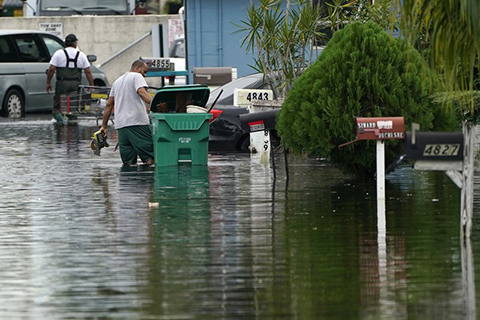By CURT ANDERSON and FREIDA FRISARO
ST. PETERSBURG, Fla. (AP) — Eta regained hurricane strength Wednesday morning as Florida braced for a second hit from the storm along the Gulf of Mexico coast near the heavily-populated Tampa Bay region.
The storm’s maximum sustained winds increased to around 75 mph (120 kph) off Florida’s southwest coast as it moved northward.
Forecasters at the National Hurricane Center in Miami issued a hurricane watch for a 120-mile (193-kilometer) stretch that includes Tampa and St. Petersburg. The storm has been in the Gulf of Mexico since crossing over South Florida on Sunday.
The Tampa Bay region is home to more than 3.5 million people across five coastal counties. No mandatory evacuations were immediately ordered but authorities began opening shelters for anyone needing them.
Tampa Mayor Jane Castor said special care is taken at shelters to protect people from the coronavirus, such as social distancing, and suggested people bring their own masks.
“Everything will be done to make sure all of our residents are safe,” Castor said.
The latest hurricane watch extends from Anna Maria Island, which is south of St. Petersburg, to Yankeetown.
The forecast prompted school officials in Pinellas and Pasco counties, which includes St. Petersburg, to send students home early Wednesday. Both counties announced schools would remain closed Thursday, as did neighboring Hillsborough County.
The Florida Highway Patrol closed the Sunshine Skyway Bridge that links Pinellas and Manatee counties because of high winds. Tampa International Airport tweeted that it would suspend operations at 3 p.m. Wednesday.
In Pasco County, officials set up four do-it-yourself locations for people to fill sandbags. In Tampa, the Busch Gardens theme park announced it is closed Wednesday and several Veterans Day events in the area were canceled.
A coronavirus testing site at Tropicana Field was also closed Wednesday.
Eta was centered about 145 miles (235 kilometers) south-southwest of Tampa on Wednesday and moving north-northeast near 10 mph (17 kph).
The hurricane center said “life-threatening storm surge” is possible early Thursday, and forecasters advised residents to heed warnings from local officials. Tropical storm-force winds are expected in the area by late Wednesday.
Forecasts call for more rain from the storm system over parts of already drenched South Florida.
“Never seen this, never, not this deep,” said Anthony Lyas, who has lived in his now-waterlogged Fort Lauderdale neighborhood since 1996. He described hearing water and debris slamming against his shuttered home overnight as the storm crossed Florida.
The storm first hit Nicaragua as a Category 4 hurricane and killed nearly 70 people from Mexico to Panama, before moving into the Gulf of Mexico early Monday near where the Everglades meet the sea, with maximum sustained winds of 50 mph (85 kph).
There was nowhere for the water to go across much of South Florida, which had already experienced nearly 14 inches (35 centimeters) of rain in October.
Eta hit land late Sunday as it blew over Lower Matecumbe, in the middle of the chain of small islands that form the Keys, but the heavily populated areas of Miami-Dade and Broward Counties bore the brunt of the fury.
It was the 28th named storm of a busy Atlantic hurricane season, tying the 2005 record for named storms. And late Monday, it was followed by the 29th storm — Theta.
The U.S. National Hurricane Center in Miami said Theta broke the record of 28 named storms in 2005. Theta was centered Wednesday morning about 740 miles (1,190 kilometers) southwest of the Azores, bearing top sustained winds of 65 mph (100 kph) as that system moved east-northeast at 8 mph (13 kph).
___
Associated Press writers Kelli Kennedy and Cody Jackson in Fort Lauderdale, Florida, contributed to this report.




